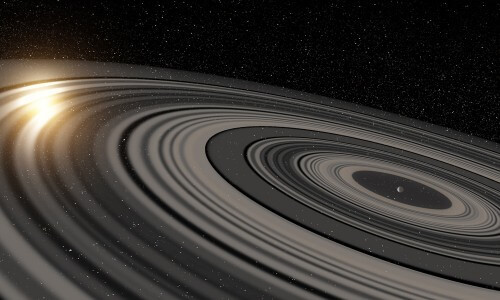"This planet is much larger than Jupiter or Saturn, and its ring system is about 200 times larger than Saturn's," said Eric Mamjek, a professor of physics and astronomy at the University of Rochester in New York. "You can think of him as a "Super - Saturn"".

Astronomers who observed a periodic dimming of the light of a relatively close star, similar to the Sun, concluded from their observations that the eclipse was caused by the passage of a planet with a huge ring system, similar to that of Saturn, but much larger. In addition, the varying spacing and densities of the rings suggest the presence of at least one large moon, and possibly more in the process of formation.
The star J1407 is an "orange dwarf" of the main series, located about 434 light years from Earth. For 57 days during the spring of 2007, "a series of complex and deep eclipses" were observed, according to the statement of an international group of astronomers, which concludes that this is the result of the existence of a huge ring system around a massive planet known as J1407b.
"This planet is much larger than Jupiter or Saturn, and its ring system is about 200 times larger than Saturn's," said Eric Mamjek, a professor of physics and astronomy at the University of Rochester in New York. "You can think of him as a "Super - Saturn"".
The observations were made by the SuperWASP mission, which uses ground-based telescopes to look for faint dimming of stars due to transiting planets.
The first study of deficiencies and possible existence of a ring system was published in 2012, led by Mamjack. Another analysis by the group estimates that the number of the main ring formations is 37, with a large interval defined approximately at a distance of 0.4 astronomical units (about 61 million km) from the "Super Saturn" which may be surrounded by a satellite the size of the Earth, During the coffee time of about two years.
The following animation shows the group's analysis of the eclipse between star J1407 and planet J1407b.
The rings of J1407b are surprisingly compact, extending to a distance of 180 million km, and their total diameter is estimated to be close to that of Earth.
"If we could replace the rings of Saturn with the rings of J1407b," says Matthew Kenworthy of the Leiden Observatory in the Netherlands and author of the new study, "they would be easily visible in daylight and would probably be much larger than the Moon in Milou."
These observations will be able to provide a look back in time, how the processes of creating the moons of Jupiter and Saturn took place.
"For decades, the planetary science community has developed theories about how planets such as Jupiter and Saturn, early in their lives, had disks around them that led to the formation of moons," according to Mamjack. Despite this, until we discovered this object in 2012, no one had seen such a ring system. This is the first glimpse of the formation of moons on a scale of millions of kilometers around a substellar object."
The planet J1407b itself is estimated to have a mass of 10-40 times that of Jupiter, technically, it may be a brown dwarf.
Additional observations will require the detection of another transit of J1407b and obtaining more information about its rings and other physical characteristics, since the duration of its orbit around the Sun is about 10 Earth years. Fortunately, 2017, the near date when such a transition is expected, is not far away.
